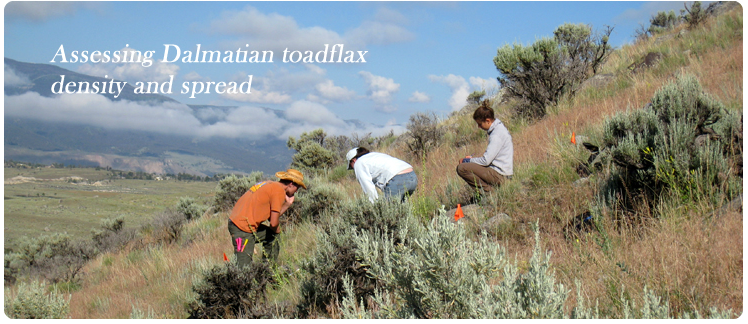Evaluating Continued NIS Management Success
Once an NIS management plan is enacted across the entire management area (i.e. at the large scale), evaluations of NIS management success should be conducted regularly (i.e. every 1-3 seasons), and records of the results of management should be maintained in such a way that they could be read and interpreted by someone unfamiliar with the management area, the land and NIS management goals, and even the NIS being targeted for management.
A list of information that you should record for each NIS you are managing is given below. It is not necessary to visit each population you treated. We recommend using a PO risk map to select representative populations in low, medium and high risk categories. These sub-samples will provide an idea of how populations in similar areas are responding to management. As before we highly recommend NOT managing a few (> 3) populations in each of the risk categories you select so you can be sure that it is your imposed management, rather than some other factor (e.g. change in grazing, climate) that is causing any observed changes.
![]() Download example monitoring_spreadsheet.xlsx or XLS or PDF
Download example monitoring_spreadsheet.xlsx or XLS or PDF
Geographic Location of All Populations. Record the geographic location (center point) of populations that you are managing
in each management area. This should be done with GPS if available, but population
locations can also be approximated by hand on a map if necessary.
Geographic Location and ID of Monitoring Populations. If you are managing a very large number of populations, select a sub-set of these
to monitor. Use your PO map to select multiple populations in low, medium, and high
PO areas. Select an equal number of populations in each PO category if possible. Make
sure to keep track of the geographic locations and population ID’s of your monitoring
populations.
NIS Management Objective. Remember to be specific! For example write “Decrease spotted knapweed cover by 50%
within 2 years” or “Reduce the infested area by 20% within 5 years”, instead of “reduce
knapweed cover”.
Pre-Management NIS Abundance and/or Area. In order to determine if management was effective, you must record the pre-management attributes of NIS. This can be accomplished in at least
three ways described below using visuals. If you didn’t perform pre-management sampling
it is VITAL that you leave some patches (or parts of patches) un-managed and record
these plots in the same way you record data on your managed plots over the coming
years.
- Record the perimeter of NIS populations with a GPS.

- Record stem density or % cover of the NIS in plots within populations.

- Photo Monitoring *This procedures above should be completed at a time when the NIS
is easily identified and seasonal growth has reached its maximum.

Management History. Record the management information for the area each year even if you don’t sample
each year. When was the management applied? What specifically was used and, if applicable
what rate of herbicide was used? For example, an entry for management history might
look like this: Initial Treatment, 5-31-07, sheep grazing (20 sheep, penned in 150ftx150ft enclosure,
rotated every 5 days)
Current NIS Abundance and/or Area. Use exactly the same method you used to estimate pre-management NIS attributes at
the same time of year. This is essential to determine if you have met your NIS management
objectives.
NIS Management Success. Use the NIS monitoring data (i.e. the pre and current abundance and area data) you
collected to assess whether or not your current management strategy is helping you
meet your NIS management objectives. If it is not, determine how you might be able
to change your NIS management to better meet your objectives.
Land Management Success. Remember that NIS management is usually enacted in order to help meet some broader
land management goals. Therefore, you must ensure that NIS management is not interfering
with these goals. If you are not the primary stakeholder, make sure that you are given
a clear list of land management goals so that you can determine if your NIS management
strategy is compatible with those goals


